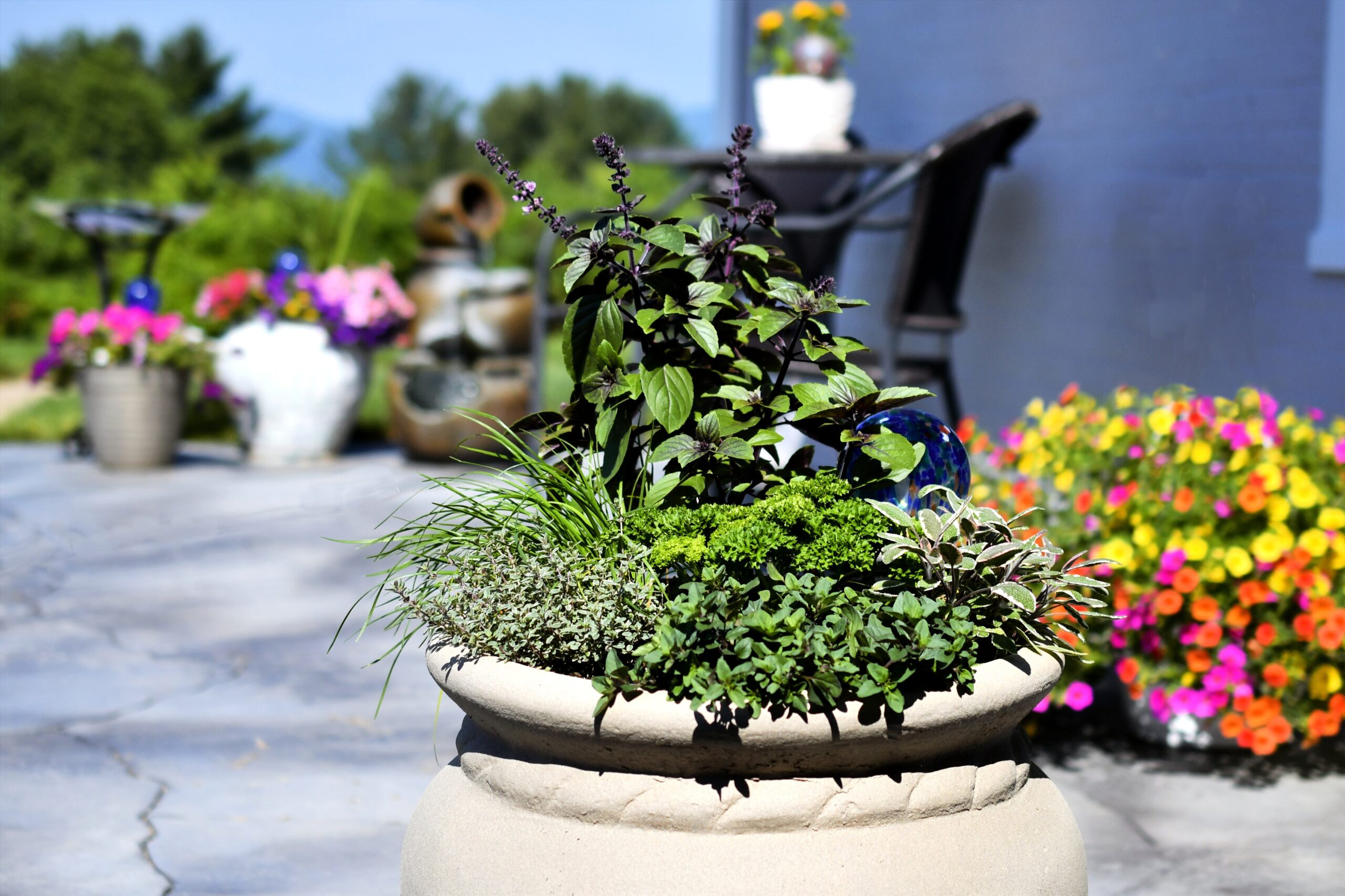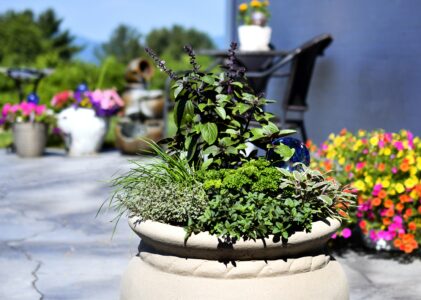Today we’re going to tackle the challenges we face when trying to grow our little green havens in the concrete jungle. I know firsthand how difficult it can be to find enough room for all your plants when you’re living in the city. Space is a precious commodity, and that’s especially true when it comes to gardening. However, don’t fret, my friends! I’ve got some excellent tips and tricks to help you overcome these obstacles and make the most of the limited space you have.
One of the best ways to maximize your gardening potential in an urban environment is to explore container and vertical gardening. These methods are perfect for small spaces, as they allow you to grow a wide variety of plants without needing a massive plot of land. Not only do container and vertical gardening help you make the most of your available space, but they also open up a world of creative possibilities for designing your garden.
Container and vertical gardening can truly transform your small urban space into a lush, thriving oasis. By using containers, you can easily move your plants around to optimize their growing conditions, and you’ll have more control over factors like soil quality and drainage. Vertical gardening techniques, on the other hand, let you make the most of your available vertical space, allowing you to grow plants on walls, fences, or even balconies. Together, these methods will help you create a beautiful, productive urban garden that you can be proud of.
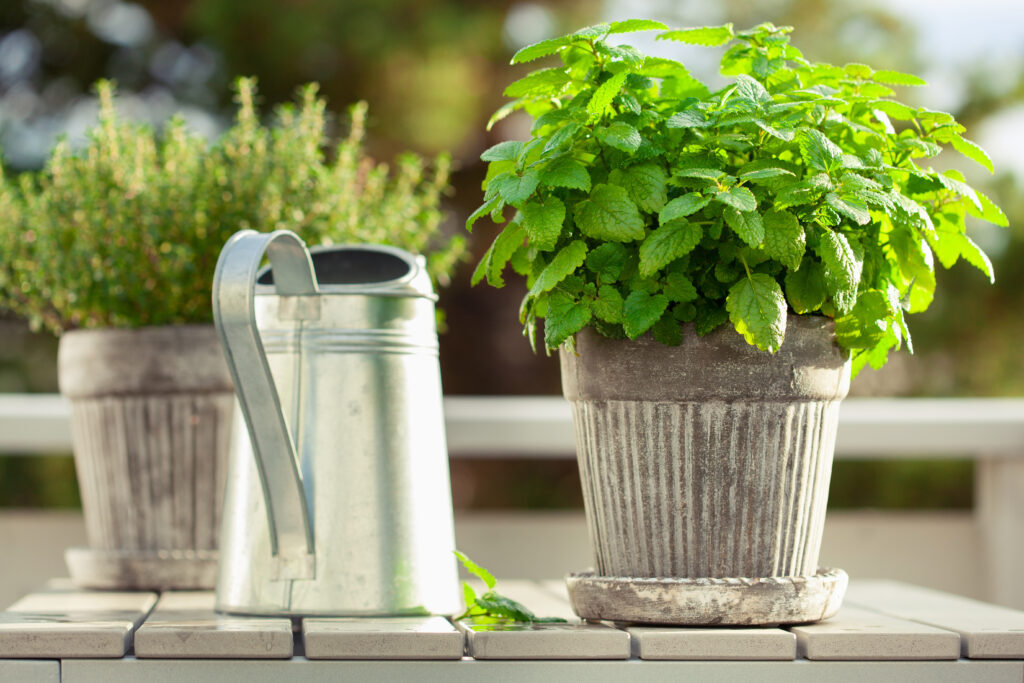
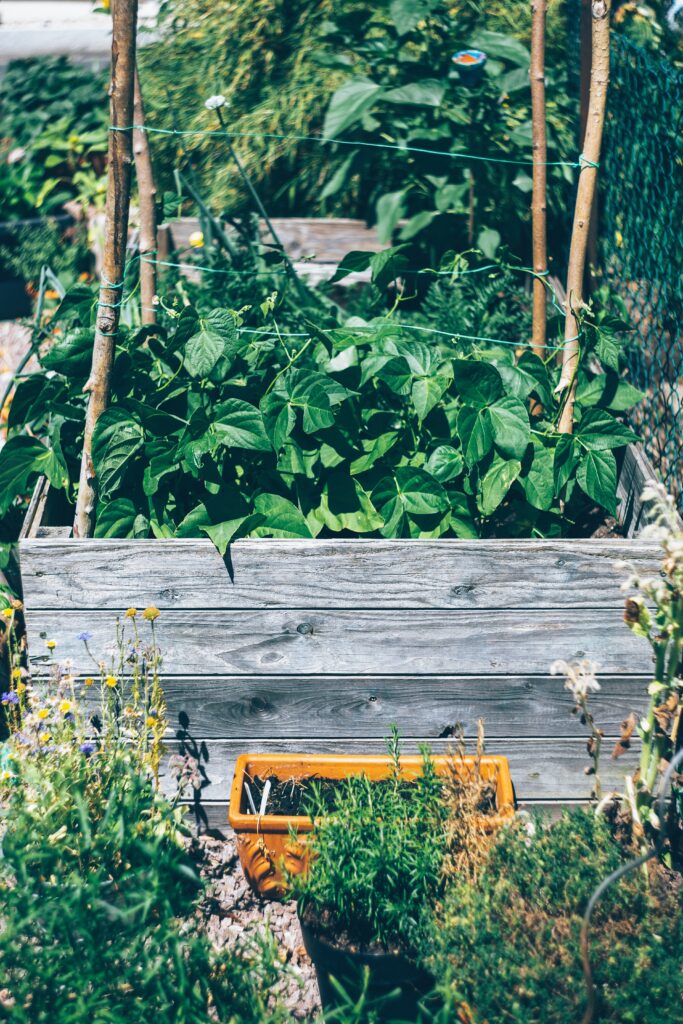
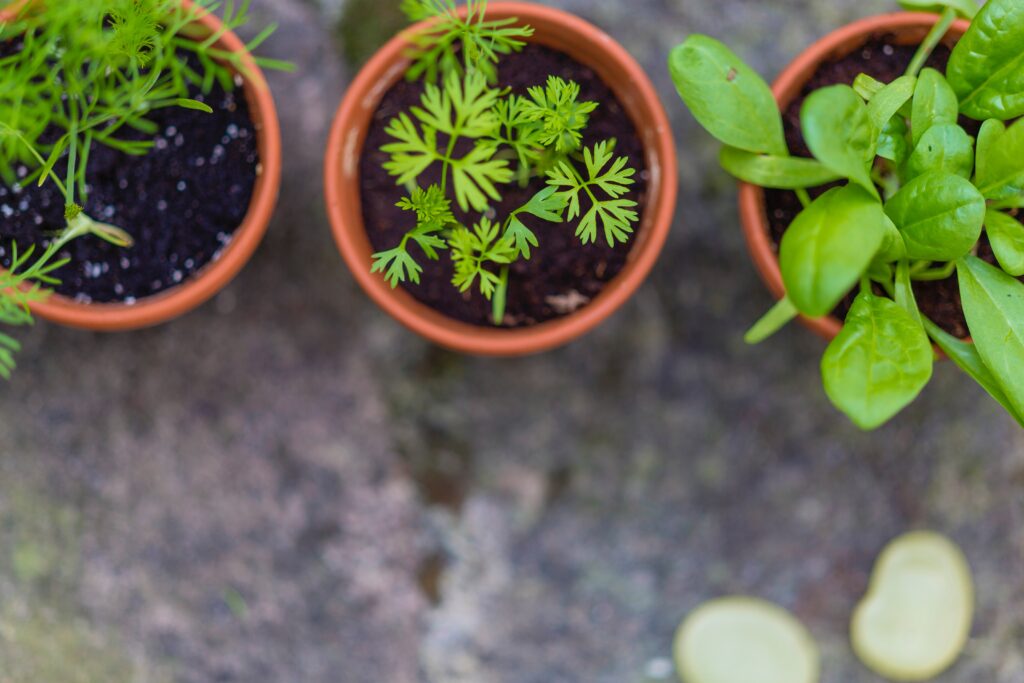
Choosing the Right Containers
When it comes to container gardening, picking the right container is crucial for your plants’ success. There’s a wide variety of container types and materials to choose from, each with its own benefits and drawbacks. Let’s explore some of the options out there and discuss specific product examples for each type, so you can make an informed decision for your urban garden.
A. Different container types and materials
Plastic: Plastic containers are lightweight, affordable, and come in a wide range of colors and styles. They’re great for retaining moisture, which can be a boon for some plants but a drawback for others that prefer well-draining soil. The Bloem Saturn Planter is a popular plastic option with a classic design and built-in saucer to catch excess water.
Ceramic: Ceramic pots are beautiful, heavy-duty, and come in various designs and glazes. They’re excellent for heat retention but can be heavy and more prone to breakage. The La Jolíe Muse Ceramic Flower Pot is a stylish option with a unique pattern and drainage hole to prevent overwatering.
Fabric: Fabric containers, like the popular Smart Pots, are made of breathable material that promotes better root growth and prevents overwatering. They’re lightweight, easy to store when not in use, and help to maintain a consistent temperature for your plants’ roots.
Metal: Metal containers, such as galvanized steel or copper pots, can add a rustic, industrial touch to your garden. They’re durable and long-lasting, but they can also heat up quickly in the sun, potentially harming your plants’ roots. The VEVOR Galvanized Raised Garden Bed is a classic, durable choice for those who prefer a metal container.
Wood: Wooden containers, like cedar or redwood planters, provide a natural, organic look to your garden. They’re sturdy and long-lasting but may require more maintenance to prevent rot or insect damage. The Jumbl Raised Canadian Cedar Garden Bed is a popular wooden option that offers ample space for planting and a chemical-free, rot-resistant construction.
B. Factors to consider when choosing containers
When selecting containers for your urban garden, there are several essential factors to consider. These include drainage, size, and weight. By keeping these aspects in mind, you’ll be able to choose containers that best suit your plants and your gardening space.
Drainage: Proper drainage is crucial to prevent overwatering and root rot. Look for containers with drainage holes, or be prepared to drill your own. Some containers, like the Lechuza Classico Self-Watering Planter, have built-in sub-irrigation systems that ensure optimal drainage and prevent waterlogging.
Size: The size of your container should be appropriate for the type of plants you want to grow. Larger containers provide more room for root growth, but they can also be heavier and more challenging to move. For example, the Keter Urban Bloomer is perfect for growing multiple plants or larger vegetables, while smaller options like the Mkono 5.5-Inch Plastic Planters are better suited for herbs or compact plants.
Weight: Keep in mind the weight of the container, especially if you plan to move your plants around or if you’re gardening on a balcony or rooftop. Lightweight options like fabric or plastic containers are easy to move, while heavier materials like ceramic or concrete may require more planning and support. The UniFramPro Hanging Rail Planter, for instance, is a lightweight plastic option designed to fit over railings, making it perfect for balconies or decks where weight is a concern.
By considering drainage, size, and weight when choosing your containers, you’ll be able to create a beautiful, functional urban garden that meets your plants’ needs and suits your space constraints. Don’t be afraid to mix and match different container types and materials to achieve the perfect balance of form and function in your garden.
C. Tips for container maintenance and care
To keep your urban garden thriving, it’s essential to properly maintain and care for your containers. Each type and material of container comes with its own set of maintenance requirements, so let’s go over some tips for each one.
Plastic: Plastic containers are relatively low-maintenance, but they can become brittle and crack over time, especially when exposed to extreme temperatures. To extend their lifespan, clean them periodically with a mild soap and water solution, and keep them out of direct sunlight when not in use.
Ceramic: Ceramic pots are prone to cracking or chipping, so handle them with care. To clean them, use a mild soap and water solution, and scrub gently with a soft brush. If your ceramic pot has a porous, unglazed interior, avoid using harsh chemicals that could be absorbed and harm your plants.
Fabric: Fabric containers, like Smart Pots, can be machine washed or hand-washed with a mild soap and water solution. Be sure to air dry them thoroughly before reusing or storing them. Regularly check for signs of wear and tear, and replace them as needed to ensure proper root aeration and drainage.
Metal: Metal containers are durable but can rust or corrode over time. To maintain them, clean them with a mild soap and water solution, and gently scrub any rust spots with a wire brush. If your metal container has a painted or coated surface, avoid using abrasive cleaners that could damage the finish.
Wood: Wooden containers, such as cedar or redwood planters, require a bit more maintenance to prevent rot and insect damage. Periodically inspect your wooden containers for signs of decay, and treat them with a wood preservative if needed. For example, Thompson’s WaterSeal Timber Oil not only preserves the wood but also enhances its natural beauty, while the Eco Advance Exterior Wood Water Repellent is a non-toxic, eco-friendly option for protecting your wooden containers from moisture damage. If the container is painted or sealed, make sure to maintain the protective coating to extend its lifespan. Regularly applying a protective finish like the Minwax Helmsman Spar Urethane will help shield your wooden containers from the elements and keep them looking great for years.
By following these container maintenance and care tips, you’ll ensure that your urban garden stays beautiful and healthy for years to come. Proper container care will not only keep your plants thriving but also help maintain the aesthetic appeal of your garden space.
Vertical Gardening Techniques
A. Trellises and climbing plants
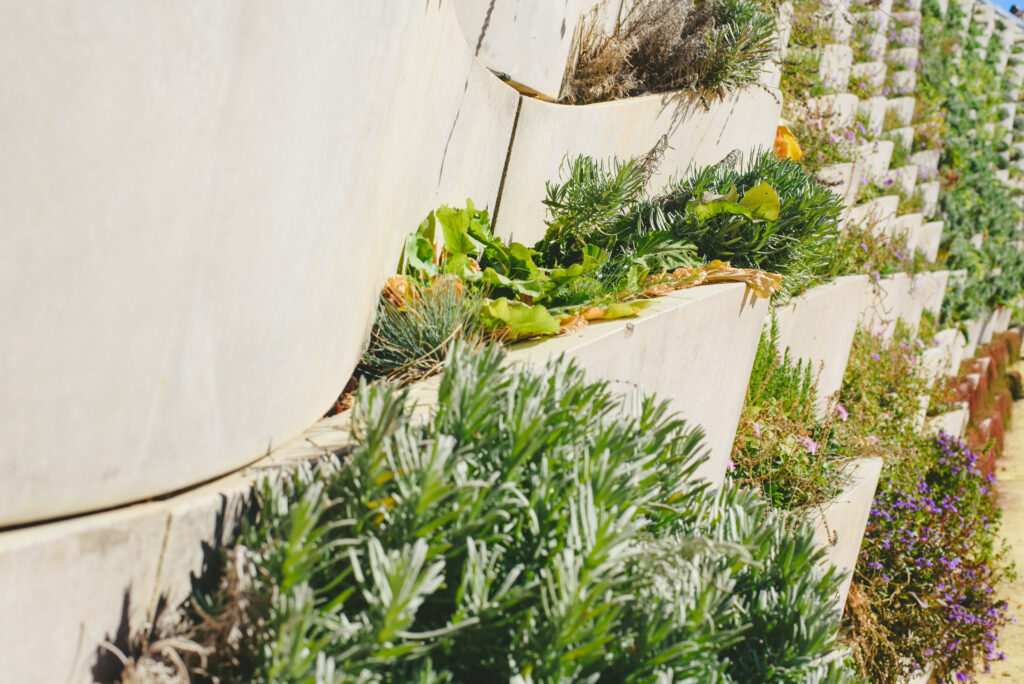
If you’re an urban gardener with a little bit of yard or garden space, trellises and climbing plants can be a fantastic way to maximize your growing area. Climbing plants not only add visual interest and height to your garden but also help save valuable ground space for other plants. Let’s take a look at five examples of climbing plants that are perfect for trellises:
- Climbing roses: These beautiful and fragrant flowers can add a romantic touch to any garden. Some popular varieties include ‘New Dawn,’ ‘Zephirine Drouhin,’ and ‘Cecile Brunner.’
- Clematis: This versatile climber produces large, showy flowers in a wide range of colors. Some favorites include ‘Jackmanii,’ ‘Nelly Moser,’ and ‘Henryi.’
- Morning glory: These fast-growing, colorful vines are ideal for covering a trellis in a single season. ‘Heavenly Blue,’ ‘Scarlet O’Hara,’ and ‘Moonflower’ are popular varieties.
- Sweet peas: Known for their lovely fragrance and delicate blooms, sweet peas make a charming addition to any trellis. Some popular varieties include ‘Cupani,’ ‘Painted Lady,’ and ‘High Scent.’
- Runner beans: Add some edible interest to your garden with runner beans, which produce long, tasty pods and attractive flowers. ‘Scarlet Emperor,’ ‘White Lady,’ and ‘Painted Lady’ are well-loved varieties.
To support these climbing plants, consider one of the following trellis products:
- Dura-Trel Winchester Trellis: A sturdy, vinyl trellis that’s easy to install and maintain.
- Gardman R361 Kensington Arch: A decorative metal arch with built-in trellis panels, perfect for adding height and visual interest to your garden.
- Panacea 89655 Giant Trellis: A tall, folding trellis with a simple yet functional design, ideal for larger climbing plants.
DIY Trellis
If you’d prefer a DIY option, here’s a brief guide to building your own wooden trellis from scratch:
Materials:
- 1×2 lumber (enough for your desired trellis size)
- Wood screws or nails
- Wood glue
- Wood stain or paint (optional)
Tools:
- Saw
- Drill or hammer
- Measuring tape
- Pencil
- Square
- Sandpaper
Instructions:
- Measure and mark the height and width you want for your trellis. Cut the 1×2 lumber to create the vertical and horizontal pieces.
- Lay out the vertical pieces on a flat surface, evenly spaced apart. Place the horizontal pieces across the vertical pieces, spacing them equally apart.
- Use a square to ensure the corners are at right angles, and mark the intersecting points where the horizontal and vertical pieces meet.
- Pre-drill holes or make pilot holes at the marked points to prevent the wood from splitting.
- Apply wood glue to the intersecting points and secure the horizontal pieces to the vertical pieces using wood screws or nails. Wipe away any excess glue.
- If desired, sand the trellis smooth and finish with a coat of wood stain or paint to match your garden’s aesthetic.
- Install the trellis in your garden by securing it to a fence, wall, or other support structure, or by inserting the bottom ends into the ground.
With a trellis and climbing plants, you can create a stunning, space-saving vertical garden that adds beauty and functionality to your urban outdoor space.
B. Wall-mounted planters and living walls
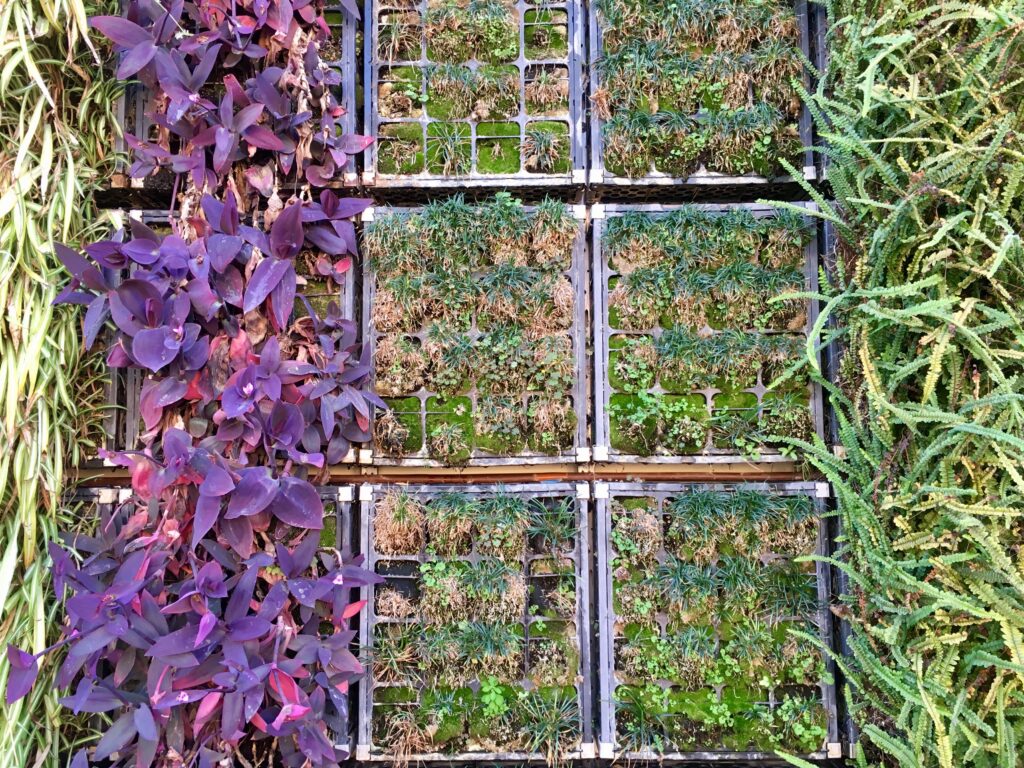
Working vertically in your urban garden not only saves precious space but also ensures that all your plants have good access to sunlight, which is essential for their growth and health. Wall-mounted planters and living walls are great solutions for those looking to create a lush, green oasis in a compact area.
Some examples of wall-mounted planter products include:
- WallyGro Eco Wall Planters: Made from recycled plastic, these modular planters can be easily hung on any wall, creating an instant vertical garden.
- Umbra Triflora Hanging Planter: This sleek, modern hanging planter features three adjustable pots that can be arranged at different heights for visual interest and optimal sunlight exposure.
- Vertical Garden USA Living Wall Planter: A self-watering planter that makes it easy to create a lush, low-maintenance living wall in your outdoor space.
The concept of living walls has its roots in ancient civilizations. One of the earliest examples dates back to the Hanging Gardens of Babylon, one of the Seven Wonders of the Ancient World. These terraced gardens, built around 600 BCE, featured a series of tiered, irrigated planters that created a lush, vertical landscape.
In the 20th century, the idea of living walls was revitalized by the French botanist Patrick Blanc, who is credited with inventing the modern living wall system. Blanc’s “Mur Végétal” or “Vertical Garden” consists of a hydroponic system that supports a wide variety of plant species, enabling the creation of stunning, biodiverse vertical gardens in urban environments.
Today, living walls have gained popularity worldwide as a sustainable, space-saving solution for greening urban spaces, improving air quality, and creating a sense of well-being for residents and visitors.
When choosing plants for a living wall, consider selecting vegetables, fruits, and flowers that have shallow root systems and are suited for vertical growth. Some examples include:
- Vegetables: Lettuce, spinach, kale, Swiss chard, and various herbs like basil, parsley, and thyme are well-suited for living walls due to their shallow roots and compact growth habits.
- Fruits: Strawberries, cherry tomatoes, and some varieties of dwarf or trailing raspberries and blackberries can be grown in living walls, providing both edible produce and visual interest.
- Flowers: Many flowering plants, such as nasturtiums, petunias, pansies, and marigolds, are excellent choices for adding color and beauty to a living wall.
Living Walls
Living walls also provide the opportunity for companion planting, which is the strategic placement of different plant species in close proximity to benefit each other. This method can help reduce pests, support healthy growth, and even improve flavor. For example, planting basil alongside tomatoes not only enhances the taste of the tomatoes but also helps repel insects like aphids, whiteflies, and hornworms. Similarly, marigolds can be incorporated into a living wall to deter various pests, while their bright blooms attract beneficial pollinators. Planting nasturtiums near brassicas like kale and cabbage can act as a trap crop for aphids, drawing them away from your more valuable plants. By thoughtfully selecting and arranging companion plants in your living wall, you can create a thriving, symbiotic garden that benefits from natural pest control and mutual support.
By incorporating wall-mounted planters and living walls into your urban garden, you can create a stunning vertical landscape that maximizes space and sunlight, while enhancing the aesthetic and environmental appeal of your outdoor area.
C. Hanging baskets and tiered planters
For urban gardeners with limited space like porches or balconies, and little or no access to outdoor soil, hanging baskets and tiered planters offer practical and visually appealing solutions for growing plants. Hanging baskets, as the name suggests, are suspended containers that can be hung from various structures like railings, awnings, or hooks. They’re particularly well-suited for trailing plants and can add a lush, cascading effect to small spaces. Tiered planters, on the other hand, consist of multiple levels or layers of containers, allowing you to grow a variety of plants vertically in a compact area. These planters work best in locations with adequate floor space and are ideal for showcasing a diverse collection of plants with different heights, textures, and colors.
When it comes to hanging baskets, there are several fruits, vegetables, and flowers that thrive in this environment:
Fruits and Vegetables:
- Strawberries: Compact and trailing varieties like ‘Temptation’ and ‘Toscana’ are perfect for hanging baskets.
- Cherry tomatoes: ‘Tumbler’ and ‘Tumbling Tom’ are popular varieties that produce an abundance of small, flavorful tomatoes in hanging baskets.
- Dwarf beans: ‘Hestia’ is a compact variety that produces tender, tasty beans in hanging containers.
- Peas: ‘Little Marvel’ and ‘Tom Thumb’ are compact, bush-type peas that can be grown in hanging baskets.
- Lettuce: Loose-leaf varieties like ‘Lollo Rosso’ and ‘Black Seeded Simpson’ can be grown in hanging baskets for easy harvesting.
Flowers:
- Petunias: Trailing varieties like ‘Surfinia’ and ‘Wave’ create a colorful, cascading effect in hanging baskets.
- Fuchsias: ‘Swingtime’ and ‘Marinka’ are two beautiful, trailing varieties that work well in hanging baskets.
- Begonias: The cascading habit of ‘Illumination’ and ‘Encanto’ varieties make them suitable for hanging baskets.
For tiered planters, consider the following fruits, vegetables, and flowers that flourish in this type of container:
Fruits and Vegetables:
- Radishes: ‘Cherry Belle’ and ‘French Breakfast’ are fast-growing varieties that can be easily grown in tiered planters.
- Spinach: ‘Bloomsdale’ and ‘Baby’s Leaf’ are nutritious leafy greens that thrive in tiered containers.
- Carrots: ‘Parisian’ and ‘Little Finger’ are compact varieties that can be grown in the shallow tiers of a tiered planter.
- Chard: ‘Bright Lights’ and ‘Rhubarb’ chard add color and texture to tiered planters.
- Herbs: Basil, parsley, cilantro, and chives are all suitable for growing in tiered containers.
Flowers:
- Pansies: ‘Matrix’ and ‘Delta’ series pansies are compact and colorful, making them ideal for tiered planters.
- Alyssum: ‘Snow Princess’ and ‘Easter Bonnet’ varieties add a delicate, fragrant touch to tiered containers.
- Marigolds: ‘Janie’ and ‘Bonanza’ series marigolds create a vibrant, pest-repellent display in tiered planters.
By utilizing hanging baskets and tiered planters, you can transform your porch or balcony into a thriving, space-efficient garden, bursting with a variety of fruits, vegetables, and flowers.
D. Vertical garden structures: Pallet gardens and vertical garden kits
For those who enjoy DIY projects and have some handy skills, vertical garden structures like pallet gardens and vertical garden kits can be a fun, rewarding way to create an urban garden. These options allow you to make the most of your vertical space while putting your creativity and craftsmanship to good use.
Pallet Gardens:
Standing Pallet Garden:
a. Find a sturdy, untreated wooden pallet. Check for any loose boards or nails and repair if necessary.
b. Sand the pallet to remove any rough edges or splinters.
c. Attach landscape fabric to the back, sides, and bottom of the pallet using a staple gun, leaving the top and front open for planting.
d. Fill the pallet with good-quality potting soil, ensuring it reaches all the gaps between the slats.
e. Plant your chosen plants between the slats, making sure they are secure and well-spaced.
f. Water the plants thoroughly and let the pallet garden remain horizontal for a week or two, allowing the plants to establish their roots.
g. Once the plants are established, move the pallet garden to a vertical position and secure it to a wall or fence using brackets or hooks.
Laid-Back Pallet Garden:
a. Find a sturdy, untreated wooden pallet and sand it to remove any rough edges or splinters.
b. Lay the pallet flat on the ground with the slats facing up.
c. Fill the gaps between the slats with good-quality potting soil.
d. Plant your chosen plants between the slats, ensuring they are secure and well-spaced.
e. Water the plants thoroughly and let them establish their roots while the pallet remains horizontal.
f. Place the pallet garden at a slight angle against a wall or fence, allowing water to drain properly and providing support.
Vertical Garden Kits:
- Watex PGWSK-2 Urban Farming Vertical Garden Kit: This easy-to-assemble kit includes two tiers of planters, mounting brackets, and an irrigation system.
- 9-Pocket Wall Hanging Planter: A modular vertical garden kit with nine pockets that can be easily mounted on a wall or fence.
- Garden Tower 2 Vertical Garden Planter: A 50-plant, rotating, vertical garden planter that also functions as a composting system, requiring some assembly.
- Outland Living 6-Ft Vertical Garden Bed: This elevated vertical planter features six tiers and requires assembly, making it perfect for those who enjoy putting things together.
- GreenStalk Patented Large 5 Tier Vertical Garden Planter: This stackable planter system allows for easy assembly and customization, accommodating various plant sizes and types.
By exploring these vertical garden structures, you can create a unique, space-saving garden that reflects your personal style and showcases your DIY skills.
IV. Combining Containers and Vertical Gardening
A. How to create a cohesive, visually appealing urban garden space
Combining various container and vertical gardening techniques can result in a visually stunning, space-efficient, and productive urban garden. By carefully selecting containers and structures that complement one another and arranging them to maximize the use of available space, you can create a cohesive, visually appealing garden that reflects your personal style and meets your gardening needs.
Modern gardens have come a long way from their traditional counterparts. Over time, urban gardeners have adapted and experimented with new materials, techniques, and designs to create gardens that are both functional and aesthetically pleasing. The history of modern garden aesthetics has been shaped by factors such as limited space, the need for sustainable practices, and the desire for convenience and low maintenance. As a result, today’s urban gardens often incorporate a mix of materials, including repurposed and recycled items, as well as innovative, space-saving techniques like vertical gardening.
Modern agricultural and gardening advancements have enabled urban gardeners to grow a diverse range of plants in small spaces while reducing the impact on the environment. The use of lightweight, durable materials for containers and structures has made it possible to easily move and rearrange gardens as needed. Additionally, techniques like hydroponics and aeroponics have transformed the way plants are grown, allowing for more efficient use of resources and greater flexibility in garden design.
As you embark on the journey of creating your own unique urban garden, remember that you are more than capable of doing this. Your creativity and artistic talents can guide you in crafting a beautiful, functional space that reflects your personal style and passion for gardening. Don’t be afraid to experiment with different container and vertical gardening techniques, as this is how you’ll discover what works best for you and your plants.
Trust your instincts and let your heart lead you in exciting directions. Gardening is an incredibly rewarding experience that allows you to connect with nature, nurture living things, and express yourself. As you combine containers and vertical gardening elements, you’ll find that your urban garden becomes an ever-evolving canvas that brings joy, beauty, and sustenance to your life. So go ahead, let your imagination run wild, and watch as your dream urban garden comes to life!
B. Maximizing space with multi-functional features
Incorporating multi-functional features into your urban garden not only helps maximize your available space but also adds an extra touch of creativity and practicality. These features serve multiple purposes, such as providing seating, storage, and aesthetic appeal while also functioning as planters or gardening structures. Embrace your inner designer and explore the possibilities of multi-functional features to create an urban garden that is both beautiful and efficient.
Benches with built-in planters:
Combining seating with planting space, benches with built-in planters can transform your urban garden into a cozy, inviting oasis. These dual-purpose pieces offer a comfortable spot to relax while simultaneously showcasing your favorite plants.
- Outsunny Wooden Garden Planter & Bench: A weather-resistant, low-maintenance bench with hidden storage and a built-in planter.
- Build your own trellis planter bench
Tables with integrated planters:
Adding a table with an integrated planter to your urban garden not only provides a functional surface for dining or working but also offers additional planting space for herbs, flowers, or small vegetables.
Shelving units with built-in planters:
Shelving units with built-in planters can help you make the most of your vertical space, displaying your plants in an organized and visually appealing manner while also providing storage for gardening tools or decorative items. C-Hopetree Ladder Shelf Bookcase: A stylish, freestanding ladder shelf featuring integrated planters for a unique, space-saving display.
By incorporating multi-functional features into your urban garden, you’ll create a space that is both functional and beautiful, showcasing your artistic talents and making the most of your limited space. Let your creativity shine as you explore the possibilities of combining seating, storage, and planting in your dream urban garden.
C. Tips for arranging and organizing your garden for easy access and maintenance
Designing an urban garden requires careful planning to ensure that your plants thrive and your space remains easy to access and maintain. By thoughtfully organizing your garden, you’ll create an environment that promotes healthy plant growth while minimizing the time and effort required for upkeep. Keep the following tips in mind as you arrange your garden to optimize its layout for efficient access and maintenance.
- Group plants with similar needs together: This makes it easier to provide the right amount of water, sunlight, and nutrients to each plant. For example, group sun-loving plants together and shade-tolerant plants in another area to ensure they receive the appropriate amount of light.
- Consider plant height and growth habits: Place taller plants at the back or on the north side of your garden to avoid shading smaller plants. Allow enough space between plants for them to grow without overcrowding or competing for resources.
- Provide ample space between rows or containers: Allow for at least 18-24 inches (45-60 cm) between rows or containers to ensure easy access for watering, pruning, and harvesting. This also helps to promote good air circulation, reducing the risk of pests and diseases.
- Utilize vertical space: Make the most of your available space by incorporating vertical gardening techniques such as trellises, hanging baskets, or wall-mounted planters. This will help you grow more plants in a smaller area while still allowing for easy access and maintenance.
- Create clear pathways: Design your garden with well-defined pathways that provide easy access to all areas for watering, pruning, and harvesting. This will also help to prevent soil compaction, which can negatively impact plant growth.
- Plan for irrigation: If possible, install a drip irrigation system or group containers near a water source to simplify watering tasks. Consider using self-watering containers or installing an automatic watering system for added convenience.
- Organize tools and supplies: Keep frequently used gardening tools and supplies within easy reach to save time and effort. Consider installing a small shed, storage bench, or wall-mounted rack to keep your tools organized and accessible.
- Rotate crops: Practice crop rotation in your garden to help prevent the build-up of pests and diseases while also improving soil fertility. Rotate plant families to different locations in your garden each year, following a three- or four-year cycle.
By carefully planning the layout of your urban garden, you’ll be able to create a space that is both visually appealing and easy to maintain. With proper organization, you can enjoy the satisfaction of growing your own food, flowers, or foliage in a space that is tailored to your needs and preferences.
V. Tips for Success
A well-planned urban garden is just the beginning; maintaining it and ensuring your plants thrive requires consistent care and attention. In this section, we’ll discuss essential aspects of successful urban gardening, including watering and fertilizing considerations, managing pests and diseases in compact spaces, and providing support for vertically-growing plants.
A. Watering and fertilizing considerations for container and vertical gardens
Container and vertical gardens have unique watering and fertilizing needs compared to traditional in-ground gardens. Due to their limited soil volume, they may require more frequent watering and specialized nutrients to ensure optimal plant growth.
Watering frequency: Containers and vertical gardens often require more frequent watering because they dry out faster. Be sure to check the soil moisture regularly and water your plants when the top inch of soil feels dry. Consider using a moisture meter, like the Gouevn Soil Moisture Meter, to accurately monitor soil moisture.
Watering techniques: Use gentle watering methods, such as a watering can with a fine rose or a soaker hose, to avoid disturbing the soil and plant roots. For a more hands-off approach, try using self-watering planters like the Lechuza Cubico Self-Watering Planter or installing a drip irrigation system.
Fertilizing: Container and vertical gardens may require more frequent fertilization due to the limited soil volume and potential for nutrient depletion. Use a balanced, slow-release fertilizer, like Osmocote Smart-Release Plant Food, or an organic option like Espoma Organic Garden-tone.
By paying close attention to the unique watering and fertilizing needs of your container and vertical gardens, you’ll set your plants up for healthy growth and a bountiful harvest.
B. Monitoring and managing pests and diseases in compact spaces
Keeping an eye on the health of your urban garden is crucial to prevent pests and diseases from taking hold in your compact space.
Regular monitoring: Inspect your plants often for signs of pests or diseases, and address any issues promptly. Consider using tools like the Carson MicroBrite Plus LED Lighted Pocket Microscope to examine your plants closely for early detection.
Pest control: Opt for organic and environmentally-friendly pest control methods whenever possible. Neem oil, like Garden Safe Neem Oil Extract Concentrate, can be an effective solution for various pests. For slugs and snails, try using diatomaceous earth or a natural repellent like Ortho Bug-Geta Snail and Slug Killer.
Disease prevention: Promote good air circulation and avoid overcrowding to minimize the risk of diseases. When watering, avoid wetting the foliage, as this can encourage the growth of fungal diseases. Use a fungicide like Bonide Copper Fungicide when needed to manage diseases.
By staying vigilant and addressing pest and disease issues promptly, you can protect your compact urban garden from potentially devastating problems.
C. Providing support and structure for vertically-growing plants
In vertical gardens, it’s essential to provide adequate support and structure to keep your plants healthy and prevent them from becoming too heavy for their containers or growing spaces.
Trellises and supports: Use trellises, stakes, or other supports to guide climbing plants and ensure they have proper structure. Products like the Dura-Trel 11172 Cambridge Trellis or Gardener’s Supply Company Expandable Bamboo Poles can be helpful.
Tying and training plants: Regularly tie and train your plants to their support structures using soft, flexible ties like the Velcro Brand Garden Ties. This will prevent damage to plant stems and promote healthy growth.
Pruning and maintenance: Regularly prune and maintain your vertically-growing plants to encourage healthy, compact growth and prevent them from becoming too heavy for their support structures.
By providing proper support and structure for your vertically-growing plants, you’ll ensure they remain healthy and manageable, making it easier to maintain your urban garden.
With these tips in mind, you’ll be well-equipped to successfully manage your container and vertical garden. Regularly monitoring your plants for pests and diseases, providing appropriate support and structure, and understanding the unique watering and fertilizing needs of your urban garden will help ensure a thriving, productive, and beautiful space. Embrace the challenges and rewards of urban gardening, and enjoy the satisfaction of growing your own fresh produce in even the smallest of spaces.
It’s Up To You!
Now that you’re equipped with the knowledge and inspiration to start your own container and vertical garden, it’s time to take action. Begin by assessing your available space, then choose the most suitable techniques, containers, and plants for your specific needs. Whether you’re working with a tiny balcony or a sprawling rooftop, container and vertical gardening can transform your urban space into a thriving, green oasis.
Remember, the journey of a thousand miles begins with a single step. Start small and let your urban garden evolve as you gain experience and confidence in your gardening abilities. Before you know it, you’ll be reaping the rewards of your hard work, enjoying the fresh, homegrown produce, and the beauty your urban garden brings to your life. So go ahead, grab your gardening gloves, and let your container and vertical gardening adventure begin!
